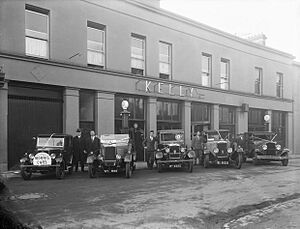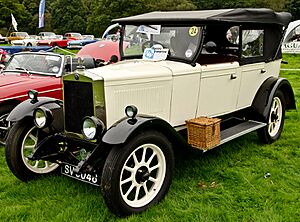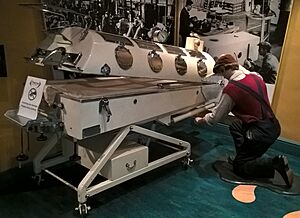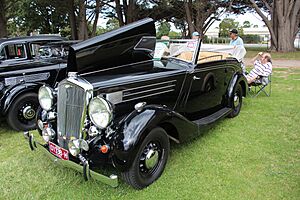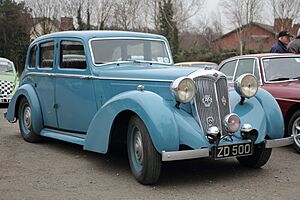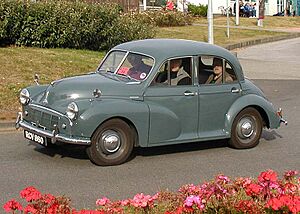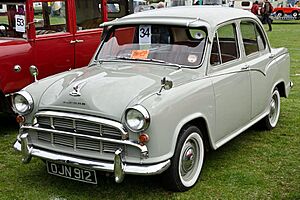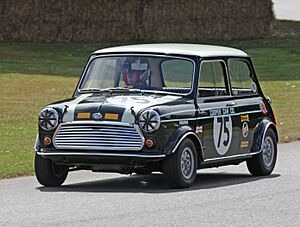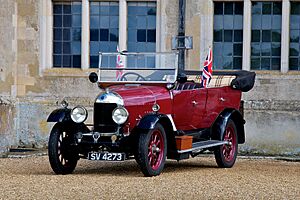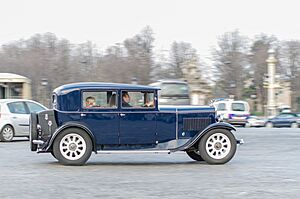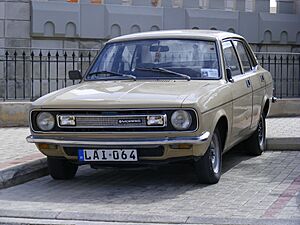Morris Motors facts for kids
 |
|
| Industry | Automotive |
|---|---|
| Fate | Individual identity retained until 1968 Ownership merged with Austin in 1952 as subsidiaries of The British Motor Corporation Limited |
| Successor | The British Motor Corporation Limited |
| Founded | 1912 W.R.M. Motors 1919 renamed as Morris Motors |
| Founder | William Richard Morris |
| Defunct | brand name used until 1984 |
| Headquarters | Cowley, Oxford, Oxfordshire, later Longbridge England, UK |
|
Key people
|
Frank George Woollard Leonard Lord |
| Products | motor cars |
| Subsidiaries | Morris Commercial Cars Limited, Nuffield Acceptances Limited, Nuffield (Australia) Limited, Nuffield Exports Limited, Nuffield Mechanizations Limited Nuffield Metal Products Limited, The Nuffield Press Limited, Nuffield Tools and Gauges Limited, Riley (Coventry) Limited, Riley Motors Limited, The M.G. Car Company Limited, The S.U. Carburetter Company Limited, Wolseley Motors Limited |
| Product type | Automotive |
|---|---|
| Owner | SAIC |
| Discontinued | 1984 |
| Previous owners | W. R. Morris (1912–1952) BMC (1952–1968) British Leyland (1968–1986) Rover Group (1986–1988) BAe (1988–1994) BMW (1994–2000) MG Rover Group (2000–2005) |
Morris Motors Limited was a British company that made cars. It started in 1919, taking over from an earlier company owned by William Morris. They kept making the same types of cars.
By 1926, Morris Motors was making 42% of all cars in Britain! This amazing growth happened because William Morris bought many parts from other companies and put them together in his own factory. He mostly paid for this growth himself using his huge profits.
Even though Morris Motors joined bigger companies in 1952, the Morris name was still used until 1984. At that time, the company British Leyland decided to focus on the more popular Austin brand and the fancier Rover brand.
For many years, Morris Oxford cars (based on a 1954-59 model) were made in India by Hindustan Motors. They were very popular there and even sold in Britain in the 1990s.
Today, part of the old Morris factory in Cowley, Oxford, is now BMW Group's Plant Oxford. This factory has been making the MINI car since 2001.
The Morris brand name is now owned by a Chinese car company called SAIC.
In 2019, a new electric van called the Morris Commercial JE was shown. It has a cool 1940s design. This van is planned to launch in 2021 under the revived Morris Commercial name, many years after the Morris brand seemed to disappear.
Contents
How Morris Motors Started
Early Days of Car Making
WRM Motors Ltd began in 1912. William Morris used to sell, rent, and fix bicycles and cars. Then, he decided to start making cars himself. He planned to build a small, light car using parts he bought from other companies. This way, he could keep control of his business with his own money.
In 1913, Morris opened a factory in Cowley, Oxford, in the United Kingdom. Here, he put together his first car, the 2-seat Morris Oxford "Bullnose". Most of the main parts for this car were bought from other companies.
By 1914, Morris added a coupé (a car with a fixed roof and two doors) and a van to his car range. However, the "Bullnose" car was too short, and its engine was too small for a 4-seat version that many people wanted. The company that made the engine, White and Poppe, couldn't make enough for Morris. So, Morris looked to Continental in Detroit, USA, for a bigger engine. He also got gearboxes and axles from the US.
Even with World War I starting, orders for cars kept coming in. From mid-1915, Morris introduced a new, larger car called the Morris Cowley, which came in 2-seat and 4-seat versions.
Growing Big Between the Wars
After the war, Morris couldn't get the Continental engine anymore. So, he arranged for a French company called Hotchkiss to make a similar engine in their factory in Coventry, England. This engine was used in new versions of the basic Cowley and the fancier Morris Oxford cars.
Morris Motors became known for making good quality cars and for lowering prices. His business kept growing and took over more of the British car market. By 1924, Morris had passed Ford to become the biggest car maker in the UK. He held 51% of the home market and made a lot of money.
William Morris had a lot of cash. He often bought the businesses of his suppliers. For example, in 1923, he bought Hotchkiss's Coventry factory, which later became the Morris Engines branch. He also brought in F G Woollard to help organize engine production. This changed how engines were made, increasing output from less than 300 engines a week to 1200! By 1924, the factory was making 2000 engines a week with only a small increase in space and workers.
Cecil Kimber, who ran Morris's original car sales and repair shop (Morris Garage) in Oxford, started building sporty versions of Morris cars in 1924. He called them MG. They were so popular that a separate MG factory was soon built in Abingdon, Oxfordshire.
Morris admired the strong, all-steel car bodies made by a company called Budd. So, in 1926, he started The Pressed Steel Company of Great Britain Limited with Budd. This factory was right across the road from Morris's factory in Cowley. It supplied car bodies to Morris and many other car makers. Morris left this partnership in 1930.
In 1928, Morris entered the small car market with the Morris Minor. This car was designed by Leonard Lord and used an 847 cc engine from Wolseley Motors, a company Morris had just bought. The Minor car also became the base for the MG Midgets. Making small cars helped Morris get through the tough economic times of the 1930s. In 1934, the Minor was replaced by the Morris Eight, which was similar to the popular Ford Model Y.
In 1932, William Morris (who was now Lord Nuffield) made Leonard Lord the Managing Director of Morris Motors. Lord quickly updated the factories, bringing in modern assembly lines. This made the Cowley plant the biggest car factory in Europe. However, Morris and Lord had a disagreement, and Lord left in 1936. He then went to work for Austin, Morris's rival. They would meet again later when their companies merged.
By 1935, Morris Motors bought the car-making businesses of Wolseley Motors and The MG Car Company from Lord Nuffield. In 1936, Lord Nuffield also sold his commercial vehicle business, Morris Commercial Cars Limited, to Morris Motors.
| 1919 | 1921 | 1923 | 1925 | 1927 | 1929 | 1932 | 1935 | 1938 | |
|---|---|---|---|---|---|---|---|---|---|
| Morris | 2 | 10 | 28 | 42 | 37 | 35 | 33 | 31 | 23 |
| Austin | 7 | 8 | 10 | 23 | 25 | 27 | 23 | 21 | |
| Ford | 22 | 11 | 2 | 6 | 4 | 6 | 17 | 18 | |
| Rootes, Standard, Vauxhall | 8 | 23 | 23 | 31 |
In 1938, William Morris became Viscount Nuffield. That same year, he sold his newly bought Riley car business to Morris Motors for £100.
The Iron Lung Project
In 1938, during a polio outbreak in London, Lord Nuffield saw a special machine called a Both Iron Lung being used. He asked for a better design that could be made using car factory methods. He arranged for about 1700 of these machines to be built at the Cowley factory. He then gave them to hospitals all over Britain and the British Empire.
These "Both-Nuffield respirators" could be made very quickly and cheaply, costing only about one-thirteenth of the American design.
Morris Companies and Brands
Morris Motors grew by adding many other companies and brands. Here are some of the important ones:
| Company/Brand | When William Morris got it | When Morris Motors got it |
|---|---|---|
| W R Morris | 1912 | 1926 |
| Morris Engines | 1923 | 1926 |
| Morris Commercial | 1923 | 1936 |
| MG | 1924 | 1935 |
| Nuffield Press | 1925 | |
| Pressed Steel | 1926 | never, but acquired by BMC in 1965 |
| SU | 1926 | 1926 |
| Wolseley | 1927 | 1935 |
| Nuffield Mechanizations | 1935 | WWII |
| Riley | 1938 | 1938 |
Morris During World War II
In 1938, Morris agreed to build a huge new factory at Castle Bromwich Assembly to make Supermarine Spitfire planes for the government. However, Morris's management had problems, and no Spitfires were delivered by May 1940. The government then took over the factory.
After a big air raid damaged the Morris Bodies factory, it started making jerry cans. Millions of these useful containers were produced for the rest of the war. The Cowley plant was used to repair aircraft and make Tiger Moth pilot training planes.
Morris also made many military vehicles during the war:
- About 10,200 Morris C8 Quad artillery prime movers (trucks that pulled cannons).
- About 2,200 Morris Light Reconnaissance Cars.
- 100 Morris CS9 armored cars.
- 21,319 Morris CS8 15cwt light trucks.
- The Morris C4 truck and Morris ML ambulance.
- 500 Morris Commercial 8x8 GS Terrapin (amphibious vehicle)s (amphibious vehicles).
- Morris Commercial CD series trucks.
After World War II
Car production started again after World War II. Morris continued making the pre-war Eight and Ten models. In 1948, the Eight was replaced by the Morris Minor. This is probably the most famous Morris car. It was designed by Alec Issigonis, who later designed the Mini. The Ten was replaced by a new 1948 Morris Oxford MO, which looked like a bigger version of the Minor. A later Morris Oxford (the 1956 Morris Oxford III) was the design for India's Hindustan Ambassador, which was made until 2014.
- The nine different cars made by Morris Motors and its wholly owned subsidiaries at the time of the formation of BMC
These cars used six different engines and five (or five and a half) car bodies. Some of the "specialist" cars were older designs, but most were very similar.
Joining British Motor Corporation (BMC)
In 1952, the Nuffield Organization (which included Morris) merged with its old rival, the Austin Motor Company. They formed the British Motor Corporation (BMC). Nuffield brought the Morris, MG, Riley, and Wolseley brands into the new company. Leonard Lord, who used to work for Morris, was now in charge. This meant Austin had a lot of power in the new company. BMC often used "badge-engineering," which means they put different brand names on very similar cars.
Becoming Part of British Leyland
In 1966, BMC bought Jaguar to create British Motor Holdings (BMH). Then, in 1968, BMH merged with Leyland Motors to form the British Leyland Motor Corporation (BLMC). Later, in 1975, the government took over, and it became British Leyland Limited (BL).
The old Morris factory complex in Cowley was the second largest factory in the BL group. However, BL had a very difficult history. BMC was almost out of money, and the new Leyland managers couldn't fix things.
The replacement for the Morris Marina and Leyland Princess cars was delayed until the 1980s. So, in 1980, the Marina was updated and renamed the Morris Ital. The Princess was updated in 1982 and became the Austin Ambassador. British Leyland later announced that the Morris brand would no longer be used for new cars. The new car that replaced the Marina and Princess was launched in April 1984 as the Austin Montego.
The Morris Ital was the last Morris-branded passenger car, with production ending in the summer of 1984. The very last vehicle to carry the Morris name was a van version of the Austin Metro. The Morris brand was completely stopped in 1987.
After many changes to BL in the late 1970s and early 1980s, the old Morris factory in Cowley and the nearby former Pressed Steel factory were used to make Austin and Rover cars. These factories continued to be used by BL's Austin Rover Group and its later company, the Rover Group. Eventually, BMW bought the Rover Group, and then a group of managers bought it, leading to the creation of MG Rover.
None of the original Morris buildings exist today. British Aerospace sold the site in 1992. It was then torn down and replaced with the Oxford Business Park. The factory next door, the former Pressed Steel site (now called Plant Oxford), is owned by BMW and makes the new MINI.
The rights to the Morris brand name are currently owned by Nanjing Automobile (Group) Corporation.
The story of William Morris's business is remembered at the Morris Motors Museum, which is part of the Oxford Bus Museum.
Some cars made at Cowley after the Morris brand stopped include the Austin/MG Maestro, Austin/MG Montego, Rover 600, Rover 800, and for a short time, the Rover 75.
The Morris Badge
The Morris badge shows an ox crossing the River Isis. This is a traditional symbol of William Morris's hometown, Oxford, and is used in the coat of arms of Oxford.
Morris Car Models (Cars, Not Vans)
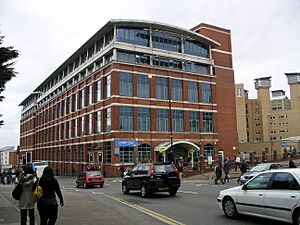
The William Morris Building
Coventry University. (photo 2007)
- 1913–1926 - Morris Oxford bullnose (12 or 14 hp)
- 1915–1931 - Morris Cowley bullnose and flatnose (12 or 14 hp)
- 1923–1924 - Morris Oxford Six F series (18 hp)
- 1926–1930 - Morris Oxford flatnose (12 or 14 hp)
- 1926–1929 - Morris Oxford 15.9 and 16/40 (16 hp)
- 1927–1929 - Morris Six (18 hp)
- 1929–1935 - Morris Isis (18 or 25 hp)
- 1928–1932 - Morris Minor (8 hp)
- 1929–1935 - Morris Oxford Six, Sixteen and Twenty (16 or 20 hp)
- 1931–1934 - Morris Cowley (12 or 14 hp)
- 1931–1933 - Morris Major (15 hp then 14 hp)
- 1932–1948 - Morris Ten (10 hp)
- 1933–1935 - Morris Ten Six (12 hp)
- 1933–1935 - Morris Cowley Six (14 hp)
- 1933–1939 - Morris "Big Six" Sixteen, Eighteen, Twenty-One, and Twenty-Five
- 1934–1939 - Morris Twelve (12 hp)
- 1935–1939 - Morris Fourteen (14 hp)
- 1935–1948 - Morris Eight (8 hp)
- 1948–1952 - Morris Minor MM (8 hp)
- 1952–1956 - Morris Minor Series II
- 1956–1971 - Morris Minor 1000
- 1948–1954 - Morris Oxford MO (14 hp)
- 1948–1953 - Morris Six MS
- 1954–1956 - Morris Oxford Series II
- 1954–1959 - Morris Cowley
- 1955–1958 - Morris Isis
- 1956–1959 - Morris Oxford Series III
- 1957–1960 - Morris Marshal (BMC Australia)
- 1958–1964 - Morris Major (BMC Australia)
- 1959–1971 - Morris Oxford Farina
- 1959–1969 - Morris Mini Minor
- 1964–1968 - Morris Mini Moke (United Kingdom)
- 1966–1973 - Morris Mini Moke (Australia)
- 1962–1971 - Morris 1100
- 1967–1971 - Morris 1300
- 1968–???? - Morris 11/55 (South African market variant of Morris 1100)
- 1969–1972 - Morris 1500 (Australia)
- 1966–1975 - Morris 1800
- 1972–1975 - Morris 2200
- 1969–1972 - Morris Nomad (Australia)
- 1971–1980 - Morris Marina
- 1980–1984 - Morris Ital
Morris-Branded Tractors
| Model | Year(s) of production | Horsepower | Engine type | Notes |
|---|---|---|---|---|
| Morris-Leyland 154 | 28 hp (21 kW) | built by BMC Sanayi in Turkey | ||
| Morris-Leyland 184 | built by BMC Sanayi in Turkey | |||
| Nuffield Morris 10/60 | 60 hp (45 kW) | built by BMC Sanayi in Turkey |
See also
- MG
- List of car manufacturers of the United Kingdom


